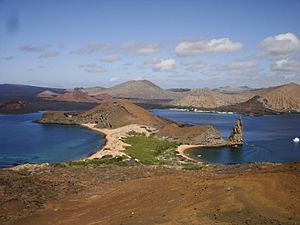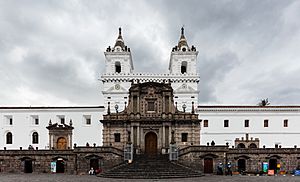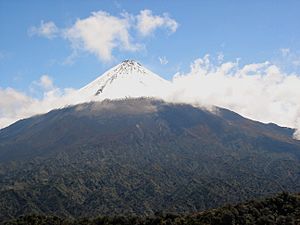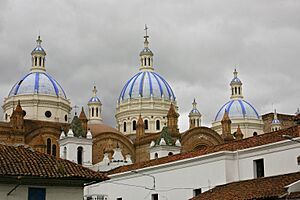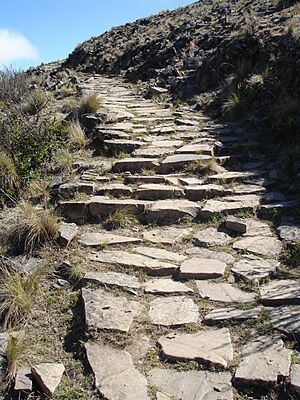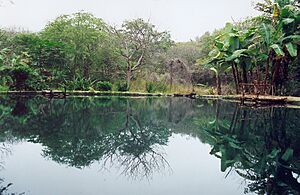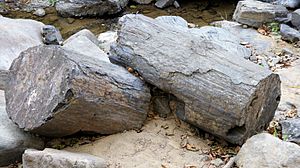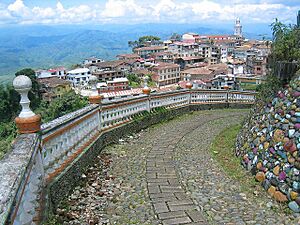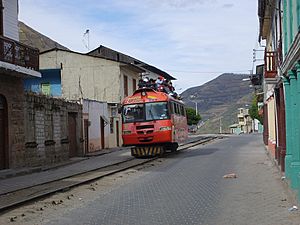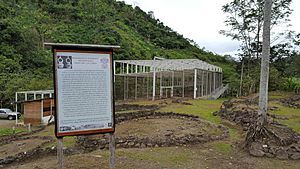List of World Heritage Sites in Ecuador facts for kids
The United Nations Educational, Scientific and Cultural Organization (UNESCO) helps protect important places around the world. These places are called World Heritage Sites. They can be important for their cultural heritage (like old buildings or archaeological sites) or their natural heritage (like special landscapes or homes for rare animals).
Cultural heritage includes amazing buildings, sculptures, and historical sites. Natural heritage covers unique physical places, special rock formations, and areas where threatened plants and animals live. These natural spots are chosen for their scientific value, beauty, or for conservation.
Ecuador agreed to protect these sites in 1975. This meant its historical and natural places could be added to the World Heritage List. Ecuador now has five sites on the list. It also has five more places that might be added in the future.
The first two sites listed in Ecuador were the Galápagos Islands and the City of Quito. Both were added in 1978. They were actually the very first two sites ever put on the entire World Heritage List! Three of Ecuador's sites are cultural, and two are natural. One site, the Qhapaq Ñan, Andean Road System, is shared with five other countries.
Amazing World Heritage Sites in Ecuador
UNESCO uses ten different rules, or "criteria," to choose World Heritage Sites. Each place must meet at least one of these rules. Rules one to six are for cultural sites. Rules seven to ten are for natural sites.
* Transnational site
| Site | Image | Location (province) | Year listed | UNESCO data | Description |
|---|---|---|---|---|---|
| Galápagos Islands | Galápagos | 1978 | 1bis; vii, viii, ix, x (natural) | This group of 19 volcanic islands is about 1,000 km (620 mi) off the coast of South America. The islands are very isolated. They are also where three ocean currents meet. This has created unique plants and animals. You can find marine iguanas, Galápagos tortoises, Galapagos penguins, and many kinds of finches. The unusual animals here inspired Charles Darwin to develop his theory of evolution after he visited in 1835. Volcanoes are always changing the islands. | |
| City of Quito | Pichincha | 1978 | 2; ii, iv (cultural) | The Spanish founded Quito in 1534. It was built on the remains of an Inca settlement. The old city center is the best preserved in Latin America. The buildings mix European and local styles. They were built to suit the high Andes mountains, at 2,818 m (9,245 ft) elevation. The city has many beautiful Baroque churches. These include the Basilica and Convent of San Francisco (pictured). | |
| Sangay National Park | Chimborazo, Morona-Santiago, Tungurahua | 1983 | 260; vii, viii, ix, x (natural) | This national park has many different environments. It goes from tropical rainforests at low levels to glaciers high in the mountains. It also has cloud forests, grasslands, and wetlands. Active volcanoes like Sangay (one of the world's busiest, pictured) and Tungurahua are always changing the land. The park is remote and home to many unique plants and animals. Important animals here include the endangered mountain tapir, Andean condor, and jaguar. | |
| Historic Centre of Santa Ana de los Ríos de Cuenca | Azuay | 1999 | 863; ii, iv, v (cultural) | The Spanish founded this city in 1557. It became a place where Spanish and local cultures mixed. The city's original grid plan is still seen today. Most buildings are from the 18th and 19th centuries. Important buildings include the New Cathedral (pictured) and the Carmelite Monastery. | |
| Qhapaq Ñan, Andean Road System* | several sites | 2014 | 1459; ii, iii, iv, vi (cultural) | Qhapaq Ñan is a huge road system built by the Inca and earlier cultures. It stretches over 30,000 km (19,000 mi) across the Andes mountains. These roads connected high peaks with rainforests, coasts, and deserts. The road system was vital for the Inca Empire. It allowed them to move goods, messengers, travelers, and armies. The site includes 273 parts like roads, bridges, and ditches. 23 of these parts are in Ecuador. This site is shared with Argentina (a section pictured), Bolivia, Chile, Colombia, and Peru. |
Future World Heritage Sites: Tentative List
Countries can also make a "tentative list" of sites they might want to nominate for the World Heritage List later. A site must be on this tentative list before it can be officially nominated. Ecuador has five places on its tentative list.
| Site | Image | Location (province) | Year listed | UNESCO criteria | Description |
|---|---|---|---|---|---|
| Parque Nacional Machalilla | Manabí | 1998 | (mixed) | This national park is on Ecuador's coast. Much of it is covered by dry tropical forests. There are also old archaeological sites here. These sites are linked to the ancient Machalilla culture. | |
| Bosque petrificado de Puyango | El Oro, Loja | 1998 | viii, ix (natural) | The fossils in this area are 70 million years old. They are from the late Cretaceous period. You can find petrified wood (wood turned into stone) and ammonites (ancient sea creatures). | |
| Zaruma ciudad minera | El Oro | 2016 | iv, v (cultural) | People mined gold in Zaruma even before the Spanish arrived. Modern mining started in the late 1800s. The wealth from gold brought many people here. This led to a mix of European and local art styles. The city's unique wooden houses have special decorations. They also have gardens for growing food. The city's layout follows the mountains, not a straight grid. | |
| Cultural Itinerary of Ecuador's Trans-Andean Train | Chimborazo, Guayas | 2016 | ii, iv, v (cultural) | This narrow-gauge railway was built between 1873 and 1908. It connected the highlands and the coast, from Guayaquil to Quito. Building it was very hard because of the tough mountains. The steepest part, called the Devil's Nose, was very challenging. The railway helped the region grow. After not running for many years, the government decided to fix the line in 2007. | |
| Mayo Chinchipe - Marañón archaeological landscape | Zamora | 2016 | iii, v (cultural) | The Mayo-Chinchipe culture lived here from 5500 BCE to 1700 BCE. They lived in the highlands of Ecuador, near the Amazon River. They traded with the coastal Valdivia culture. They imported things like sea shells. In return, they brought manioc and cacao to the coast. They might have been the first to grow cacao. The best-known site is Santa Ana (La Florida) (pictured). Here, tools, pottery, and ceremonial fireplaces have been found. |


